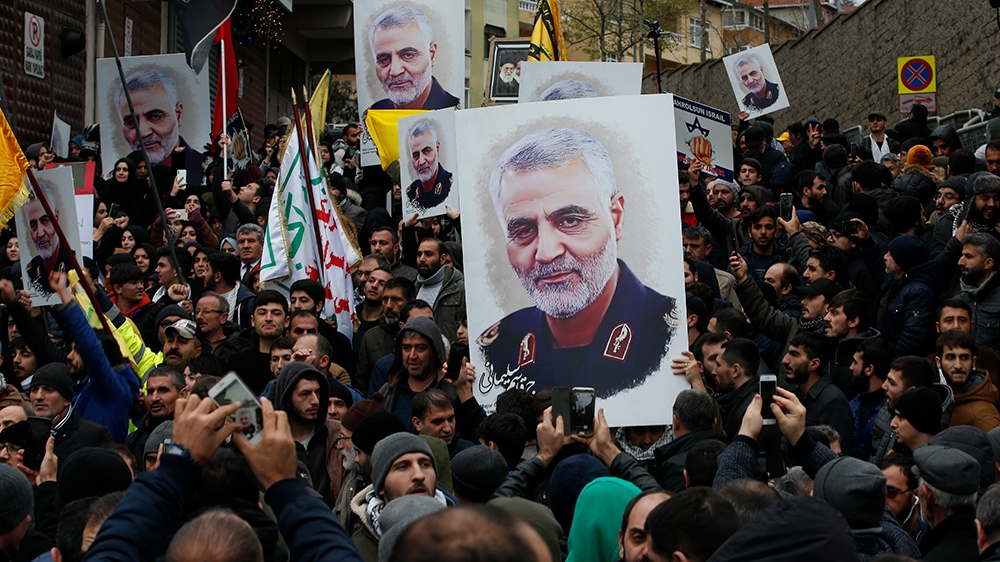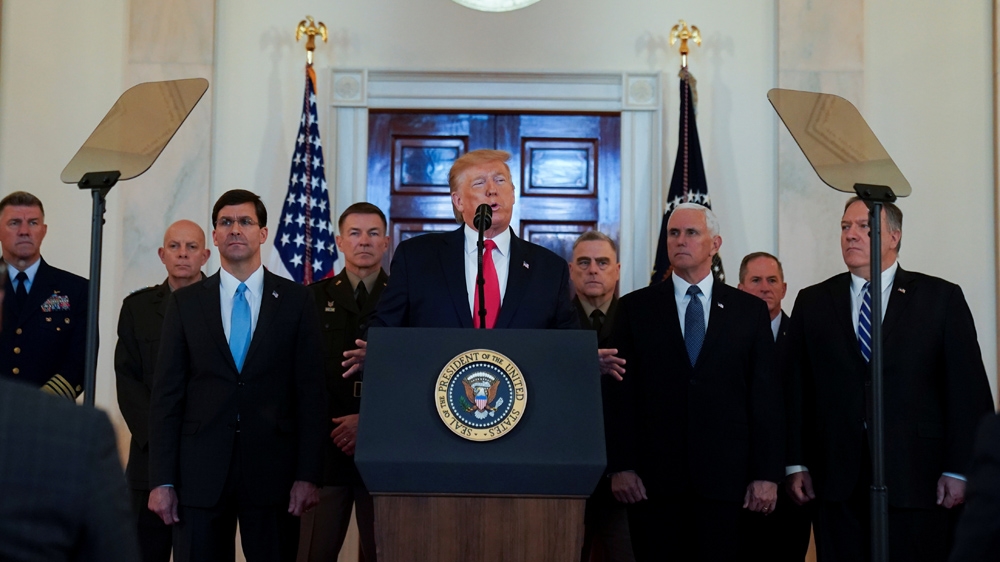Pompeo to face House panel on US killing of Iran’s Soleimani
US secretary of state set to appear for first time before a US House committee probing Trump’s justification for attack.

Washington, DC – US Secretary of State Mike Pompeo is scheduled to appear on Friday before a committee of Congress probing whether the Trump administration had adequate justification for the assassination of top Iranian commander Qassem Soleimani in Iraq earlier this year.
Pompeo’s appearance, which is scheduled for 8:30am (13:30GMT) and will be limited to two hours, will be the first time the top US diplomat has faced questions publicly from legislators about the Soleimani assassination. Pompeo is expected to make the case that Soleimani’s killing was justified and that the Trump administration’s policy of applying “maximum pressure” on Iran is working.
“Removing [Soleimani] from the battlefield was a de-escalatory measure,” Pompeo will tell the committee, according to his prepared remarks.
“His death reduced the risk to our personnel overseas and made clear we are willing and able to impose costs on our adversaries if they threaten or attack us,” Pompeo is also expected to say.
Representative Gerry Connolly, a Democratic member of the House Foreign Affairs Committee, said the committee will have “probing questions” for Pompeo.
“One always worries about unintended consequences and violence spreading throughout the region,” Connolly said.
President Donald Trump and top administration officials have given shifting explanations for the January 3 drone attack that killed Soleimani and others in his convoy at the airport in Baghdad, Iraq.
Iraqi Prime Minister Adil Abdul Mahdi had told Iraq’s parliament he was scheduled to meet with Soleimani on the morning the Iranian general was killed and that Soleimani was carrying the Iranian response to an Iraqi diplomatic initiative to foster talks between Riyadh and Tehran.

Initially, Trump, Pompeo and others said Soleimani was an “imminent threat” to American interests in Iraq. But administration officials walked back from that justification, saying they did not know “when or where” any attacks planned by Solemani would take place.
In closed-door briefings to US legislators, Trump officials were unable to provide evidence of an imminent threat and instead described Soleimani’s past activities and likely future threats, Democrats and some Republicans said.
Rebukes by Congress
Earlier this month, the Senate passed a War Powers Resolution aimed at limiting Trump’s ability to wage war against Iran. Although the measure is expected to be passed in the House, it faces a likely veto by the president.
So far, the Trump administration has failed to provide Congress with access to the underlying intelligence that officials claimed showed Soleimani was a threat. Most recently, the administration offered a fuzzy rationale in a legally mandated memo to Congress, which did not cite the “imminent threat” mentioned in previous justifications.
“I am certainly not satisfied,” said House Majority Leader Steny Hoyer told Al Jazeera on Wednesday.
“We had a classified briefing and, of course, from the classified briefing it was clear that there was other documentation on which the intelligence community and the military relied in terms of giving their advice,” Hoyer said.
“We’ve been trying to get access to those documents, which the administration relied on for the actions they took. The issue was whether it was evidence requiring such an action” he said. “We’re not happy that we have not been able to get those underlying documents.”

US legislators were broadly alarmed that Trump’s order to kill Soleimani brought the US and Iran to the brink of war and resulted in an Iranian missile attack on US troops at two Iraqi bases housing US troops. While no US forces were killed in the attack, more than 100 suffered traumatic brain injuries, officials said.
In Iran, the Iranian military mistakenly shot down a Ukrainian passenger jet, killing all 176 onboard.
In Iraq, the killing of Soleimani on Iraqi soil triggered public protests against the US military presence in the country and led to calls from the Iraqi Parliament for US troops to withdraw.
“There hasn’t been enough scrutiny on the [US’s] Iran policy, in general. On every metric that they articulated when this started, it hasn’t made things better. It has made things worse,” said Trita Parsi, executive vice president at the Quincy Institute for Responsible Statecraft in Washington, DC.
‘Consequence of withdrawal from Iran nuclear deal’
Tensions between the US and Iran have escalated since Trump withdrew the US from the Iran nuclear deal in May 2018 and implemented “maximum pressure” sanctions against Tehran.
“All of that is not only a direct result of Trump’s withdrawal from the deal, but a consequence of it,” Parsi told Al Jazeera.
“This decision to pursue a policy they themselves describe as ‘economic warfare’ is going to lead to actual warfare,” Parsi said.
The Soleimani assassination has brought into question whether the Trump administration violated international law and whether its policy of applying “maximum pressure” on Iran in the form of economic sanctions is working.
“From a European perspective, there has been a lot of difficulty and challenges in dealing with the policy,” said Aniseh Bassiri Tabrizi, a research fellow in Middle East security at the Royal United Services Institute for Defence and Security Studies in London.
“There has not been an endorsement from across the pond,” Tabrizi told Al Jazeera.
Pompeo recently returned to the US from an overseas trip that included stops in Saudi Arabia and Oman. Speaking to reporters travelling with him in Riyadh, Pompeo justified the Soleimani strike as a deterrent against aggression by Iran.
“It demonstrated resolve not only from the United States, but all of the forces that are working to push back against the Islamic Republic of Iran,” Pompeo last week.
“He was actively plotting to kill Americans. He had killed Americans. It was an important strategic strike that was taken. You can see that it’s now provided the Iranians with a deep knowledge that our notion of deterrence is real,” he said.

Contrary to the arguments by some that the pressure campaign is not meeting objectives, Aaron David Miller, a senior fellow at the Carnegie Endowment for International Peace, said the Trump administration is not really looking for negotiations or even strategic arms control.
“The maximum pressure campaign is designed to economically crush Iran and to ensure the administration remains pure in its goals not to get sucked back into a negotiation with Iranians and to avoid what the president doesn’t want, which is a major confrontation with Iran,” Miller told Al Jazeera.